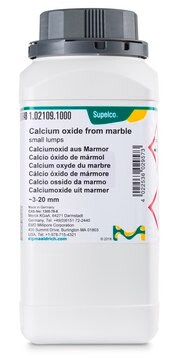239232
Calcium hydroxide
ACS reagent, ≥95.0%
About This Item
Produits recommandés
Qualité
ACS reagent
Niveau de qualité
Essai
≥95.0%
Forme
powder
Impuretés
≤0.03% insol. in HCl
≤0.1% S compounds
≤3.0% calcium carbonate
pH
12.4-12.6 (20 °C)
Densité
2.24 g/mL at 25 °C (lit.)
Traces d'anions
chloride (Cl-): ≤0.03%
Traces de cations
Fe: ≤0.05%
K: ≤0.05%
Mg: ≤0.5%
Na: ≤0.05%
Sr: ≤0.05%
heavy metals: ≤0.003% (by ICP)
Chaîne SMILES
O[Ca]O
InChI
1S/Ca.2H2O/h;2*1H2/q+2;;/p-2
Clé InChI
AXCZMVOFGPJBDE-UHFFFAOYSA-L
Vous recherchez des produits similaires ? Visite Guide de comparaison des produits
Description générale
Application
- In the pretreatment of technical lignin during the pyrolysis in a fluidized bed reactor to overcome the agglomeration to produce phenolic-rich bio-oil.
- As a catalyst in the pyrolysis of pinewood in a fixed bed reactor.
Mention d'avertissement
Danger
Mentions de danger
Conseils de prudence
Classification des risques
Eye Dam. 1 - Skin Irrit. 2 - STOT SE 3
Organes cibles
Respiratory system
Code de la classe de stockage
13 - Non Combustible Solids
Classe de danger pour l'eau (WGK)
WGK 1
Point d'éclair (°F)
Not applicable
Point d'éclair (°C)
Not applicable
Faites votre choix parmi les versions les plus récentes :
Déjà en possession de ce produit ?
Retrouvez la documentation relative aux produits que vous avez récemment achetés dans la Bibliothèque de documents.
Notre équipe de scientifiques dispose d'une expérience dans tous les secteurs de la recherche, notamment en sciences de la vie, science des matériaux, synthèse chimique, chromatographie, analyse et dans de nombreux autres domaines..
Contacter notre Service technique






